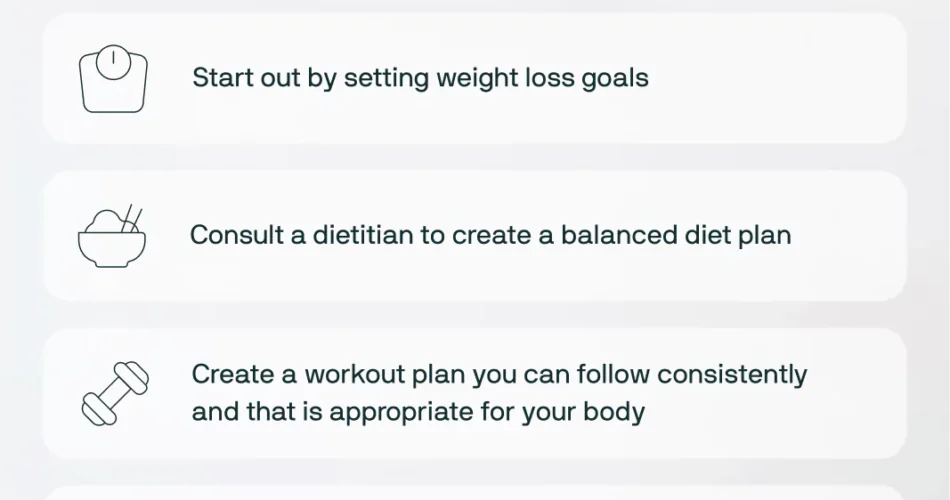Start your weight loss journey by setting realistic goals and adopting a balanced diet. Incorporate regular exercise into your routine.
Embarking on a weight loss journey can seem overwhelming, but breaking it down into manageable steps makes it achievable. Begin by setting realistic and attainable goals that keep you motivated. Focus on maintaining a balanced diet rich in whole foods, fruits, and vegetables.
Consistency is key, so gradually incorporate regular exercise into your daily routine. Monitoring your progress helps you stay on track and make necessary adjustments. Remember, patience and persistence are essential. Celebrate small victories to stay motivated and committed to your weight loss journey. This approach not only helps in shedding pounds but also promotes a healthier lifestyle overall.

Credit: chhs.source.colostate.edu
Embarking On A Weight Loss Journey
Starting a weight loss journey is exciting. It marks a new chapter. This journey requires commitment and a positive mindset. Let’s explore some tips to make this journey smoother.
Setting Realistic Goals
Set realistic goals to avoid disappointment. Break down your weight loss into smaller targets. For example:
- Lose 1-2 pounds per week.
- Reduce sugar intake by 50%.
- Exercise for 30 minutes daily.
Track your progress regularly. Use a journal or an app. Celebrate small victories. These small wins motivate you to keep going.
Creating A Supportive Environment
A supportive environment makes your journey easier. Inform your family and friends about your goals. Their encouragement helps you stay on track.
Here are some tips to create a supportive environment:
- Remove unhealthy snacks from your home.
- Stock up on fruits and vegetables.
- Find a workout buddy.
- Join a weight loss group.
Positive surroundings boost your morale. It ensures you stay focused and motivated.
Understanding Your Body
Starting a weight loss journey requires understanding your body. This helps you set realistic goals and avoid potential health risks. Knowing your body’s needs allows for a personalized approach to weight loss.
Importance Of A Medical Check-up
Before beginning any weight loss program, it is crucial to get a medical check-up. A doctor can assess your overall health and identify any underlying issues. This step ensures you are healthy enough to start a weight loss plan.
| Check-Up Components | Purpose |
|---|---|
| Blood Tests | Check cholesterol, blood sugar, and thyroid levels |
| Blood Pressure | Ensure it’s within a healthy range |
| Body Mass Index (BMI) | Determine if you are underweight, normal, overweight, or obese |
Identifying Personal Health Indicators
Understanding personal health indicators can guide your weight loss plan. These indicators include metabolism rate, body composition, and dietary habits.
- Metabolism Rate: Determines how many calories you burn daily.
- Body Composition: Measures muscle, fat, and bone percentages.
- Dietary Habits: Tracks your current eating patterns.
Tracking these indicators helps you make informed decisions. For example, knowing your metabolism rate can help set calorie goals. Understanding your body composition can guide exercise choices.
Nutrition Fundamentals
Understanding nutrition is key to starting a weight loss journey. It helps you make healthier choices and fuels your body properly.
Balancing Macronutrients
Macronutrients include proteins, fats, and carbohydrates. Each plays a vital role in your diet.
- Proteins help build and repair muscles. Include lean meat, beans, and nuts in your diet.
- Fats provide energy and support cell growth. Opt for healthy fats like avocados, olive oil, and fish.
- Carbohydrates are the body’s main energy source. Choose whole grains, fruits, and vegetables.
Incorporating Whole Foods
Whole foods are minimally processed and rich in nutrients. They support overall health and weight loss.
| Food Type | Examples |
|---|---|
| Fruits | Apples, berries, oranges |
| Vegetables | Spinach, broccoli, carrots |
| Whole Grains | Oats, quinoa, brown rice |
| Proteins | Chicken, tofu, lentils |
Focus on a variety of whole foods. They provide essential vitamins and minerals.
Designing A Customized Diet Plan
Starting a weight loss journey can be exciting and challenging. One key aspect is designing a customized diet plan. This plan should fit your lifestyle and health needs. A well-crafted diet plan keeps you motivated and on track.
Calculating Caloric Needs
To start, understand your body’s caloric needs. This helps you know how many calories to consume daily.
Use the following formula to calculate:
Men: BMR = 88.362 + (13.397 x weight in kg) + (4.799 x height in cm) - (5.677 x age in years)
Women: BMR = 447.593 + (9.247 x weight in kg) + (3.098 x height in cm) - (4.330 x age in years)
Once you have your BMR, calculate your Total Daily Energy Expenditure (TDEE) using this table:
| Activity Level | Multiplier |
|---|---|
| Sedentary (little or no exercise) | 1.2 |
| Lightly active (light exercise/sports 1-3 days/week) | 1.375 |
| Moderately active (moderate exercise/sports 3-5 days/week) | 1.55 |
| Very active (hard exercise/sports 6-7 days a week) | 1.725 |
| Super active (very hard exercise/physical job) | 1.9 |
Multiply your BMR by the multiplier that fits your activity level. This gives your TDEE.
Adapting Diets For Dietary Restrictions
Many people have dietary restrictions. Your diet plan should respect these needs. Common restrictions include:
- Gluten-free
- Lactose-free
- Vegetarian
- Vegan
For a gluten-free diet, avoid wheat, barley, and rye. Substitute with gluten-free grains like quinoa and rice.
If you’re lactose-intolerant, choose lactose-free dairy products or plant-based milk.
Vegetarians can get protein from beans, lentils, and tofu. Vegans should include a variety of vegetables, nuts, and seeds.
Always check food labels for hidden ingredients. Plan meals ahead to ensure balance and nutrition.
Exercise Essentials
Starting a weight loss journey can feel overwhelming. Incorporating the right exercise is crucial. Exercise helps burn calories, build muscle, and boost mood. Let’s explore the essential aspects of exercise for weight loss.
Choosing The Right Types Of Exercise
Choosing the right exercise is crucial for weight loss. Different exercises serve different purposes. Here are some types of exercises to consider:
- Cardio Exercises: Running, swimming, and cycling. These burn calories quickly.
- Strength Training: Lifting weights and resistance bands. These build muscle.
- Flexibility Exercises: Yoga and stretching. These improve range of motion.
Mixing different types of exercises keeps things exciting. It also works different muscle groups. This leads to better overall fitness and weight loss.
Setting An Exercise Schedule
Setting a schedule helps maintain consistency. Consistency is key to weight loss success. Follow these steps to create an effective exercise schedule:
- Determine Your Availability: Note when you are free each day.
- Set Realistic Goals: Start with small, achievable targets.
- Include Rest Days: Rest days prevent burnout and injury.
- Track Your Progress: Keep a journal or use an app.
Here’s a sample weekly exercise plan:
| Day | Exercise |
|---|---|
| Monday | 30 minutes running |
| Tuesday | Strength training |
| Wednesday | Yoga |
| Thursday | 30 minutes cycling |
| Friday | Strength training |
| Saturday | Rest |
| Sunday | Hiking |
Sticking to a schedule makes exercise a habit. Habits lead to long-term success. Always listen to your body and adjust as needed.

Credit: mangoclinic.com
Behavioral Changes For Weight Loss
Starting a weight loss journey requires more than just diet and exercise. Behavioral changes play a crucial role in achieving long-term success. Making small, consistent adjustments can help you stay on track and reach your goals.
Building Healthy Habits
Creating healthy habits is essential for sustainable weight loss. Begin by setting realistic goals. Break them down into smaller, manageable tasks. Celebrate each small victory to stay motivated.
- Plan meals ahead to avoid unhealthy choices.
- Incorporate daily physical activities, like walking or cycling.
- Keep a food journal to track what you eat and drink.
Consistency is key. Forming new habits can take time, so be patient with yourself. Small, daily actions lead to significant changes over time.
Managing Emotional Eating
Emotional eating can derail your weight loss efforts. Identifying your triggers is the first step. Recognize the emotions that cause you to eat.
| Trigger | Alternative Action |
|---|---|
| Stress | Practice deep breathing or meditation. |
| Boredom | Engage in a hobby or read a book. |
| Loneliness | Call a friend or go for a walk. |
Develop a list of alternative actions. Choose activities that bring you joy and relaxation. Seek support from friends, family, or a support group. Emotional support is vital for managing your eating habits.
Behavioral changes can significantly impact your weight loss journey. Focus on building healthy habits and managing emotional eating to achieve lasting results.
Monitoring Progress
Starting a weight loss journey can be challenging, but monitoring your progress can help keep you motivated and on track. By keeping an eye on your daily habits and making necessary adjustments, you can achieve your weight loss goals more effectively. Below are some tips on how to monitor your progress.
Tracking Food And Activity
Keeping a food diary helps you see what you eat. Write down every meal, snack, and drink. Use a mobile app or a notebook. Include portion sizes and calorie counts. Tracking your activity is also important. Note down how long you exercise and what types of activities you do. This helps you see the balance between calories in and calories out.
| Food Item | Portion Size | Calories |
|---|---|---|
| Apple | 1 medium | 95 |
| Chicken Breast | 3 oz | 165 |
| Salad | 2 cups | 150 |
Adjusting Goals As Needed
Your weight loss journey may need changes along the way. Adjust goals based on your progress. If you are losing weight too fast or too slow, tweak your plan. It’s okay to set new targets. Use the data from your food and activity tracking to make informed decisions.
- Set realistic targets
- Review your progress weekly
- Be flexible with your plan
You can also adjust the types of exercises you do. Add variety to your workout routine. This keeps things interesting and helps you stay committed. If you find certain foods are not helping, replace them with healthier options.
- Review your food diary
- Identify high-calorie foods
- Replace them with low-calorie options
Remember, the key to success is consistency. Stay focused on your goals and keep monitoring your progress.

Credit: mangoclinic.com
Overcoming Plateaus And Setbacks
Starting a weight loss journey is exciting. But, you may face plateaus and setbacks along the way. These moments can be discouraging. Yet, they are common and can be overcome. Here are some tips to help you stay on track and reach your goals.
Strategies For Breaking Through Plateaus
- Change Your Exercise Routine: Your body adapts to the same workouts. Switch up your routine to shock your muscles.
- Track Your Food Intake: Keep a food diary. Ensure you are eating balanced meals.
- Increase Protein Intake: Protein helps in muscle repair. It also keeps you fuller for longer.
- Get Enough Sleep: Lack of sleep can affect your weight loss. Aim for 7-9 hours of sleep each night.
- Stay Hydrated: Drink plenty of water. It helps with metabolism and keeps you feeling full.
Staying Motivated During Tough Times
It’s easy to lose motivation during tough times. Here are some tips to keep you going:
- Set Small Goals: Break your main goal into smaller, manageable tasks. Celebrate each victory.
- Find a Support System: Join a group or find a buddy. Sharing your journey can provide encouragement.
- Reward Yourself: Treat yourself for reaching milestones. It could be a new outfit or a relaxing day.
- Stay Positive: Focus on the progress you’ve made. Don’t dwell on setbacks.
- Visualize Success: Picture yourself achieving your goals. It can help keep you motivated.
Remember, setbacks are part of the journey. With the right strategies, you can overcome them and succeed. Stay determined and focused on your goals.
Long-term Weight Management
Starting a weight loss journey is just the beginning. The real challenge is maintaining the results over time. Long-term weight management is essential for sustaining a healthy lifestyle and avoiding the pitfalls of yo-yo dieting. Here are some practical tips to help you stay on track.
Sustaining Lifestyle Changes
Consistency is key to long-term success. Make small, sustainable changes rather than drastic ones. This helps your body adjust and makes it easier to stick with new habits.
- Balanced Diet: Focus on eating a variety of foods. Include fruits, vegetables, lean proteins, and whole grains.
- Regular Exercise: Aim for at least 30 minutes of physical activity each day. Simple activities like walking or cycling can make a difference.
- Stay Hydrated: Drink plenty of water. It helps control hunger and keeps you energized.
Track your progress. Use apps or journals to monitor your food intake and physical activity. This helps you stay accountable and motivated.
Planning For Future Challenges
Life is full of unexpected events. Plan ahead to tackle these challenges without derailing your progress.
| Challenge | Solution |
|---|---|
| Holidays & Parties | Prepare healthy snacks and limit sugary drinks. |
| Busy Work Schedule | Meal prep on weekends and schedule workout times. |
| Travel | Choose healthy options and stay active. |
Set realistic goals. Understand that setbacks happen. The key is to get back on track as soon as possible.
Build a support system. Surround yourself with friends and family who encourage your healthy habits. Join online communities for additional support and motivation.
Frequently Asked Questions
What Is The Best Way To Start Losing Weight For Beginners?
Start by setting realistic goals, eating balanced meals, and incorporating regular exercise. Track progress and stay consistent. Drink plenty of water.
How Do I Begin A Weight Loss Journey?
Start by setting realistic goals. Create a balanced diet plan. Incorporate regular exercise into your routine. Stay hydrated and get enough sleep. Track your progress and stay motivated.
How Can I Kickstart My Weight Loss?
Start by setting realistic goals. Follow a balanced diet rich in fruits, vegetables, and lean proteins. Stay hydrated and exercise regularly. Get adequate sleep and manage stress effectively. Track your progress to stay motivated.
What Is The 30/30/30 Rule For Weight Loss?
The 30/30/30 rule for weight loss involves 30 minutes of exercise, 30 grams of protein, and 30 ounces of water daily.
Conclusion
Embarking on a weight loss journey can feel daunting, but small steps lead to big changes. Stay consistent, set realistic goals, and celebrate progress. Remember, patience and persistence are key to success. With these tips, you’ll be well on your way to a healthier, happier you.
Keep pushing forward and stay motivated.


